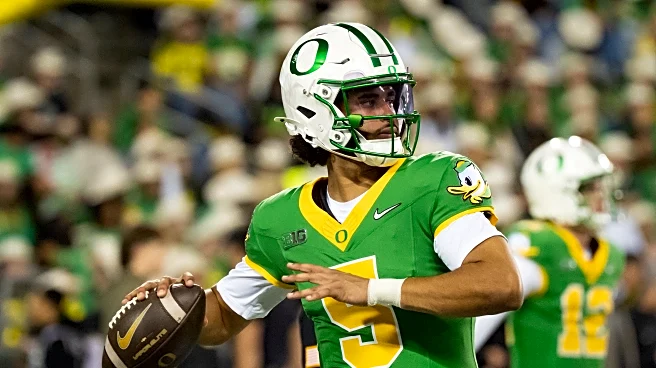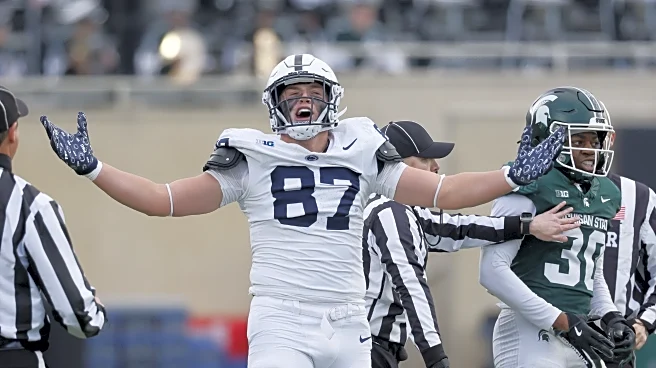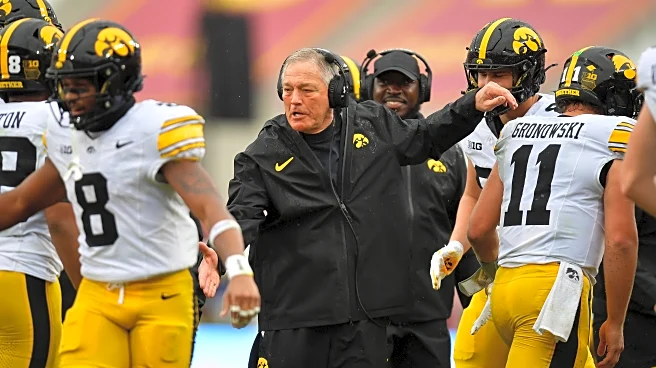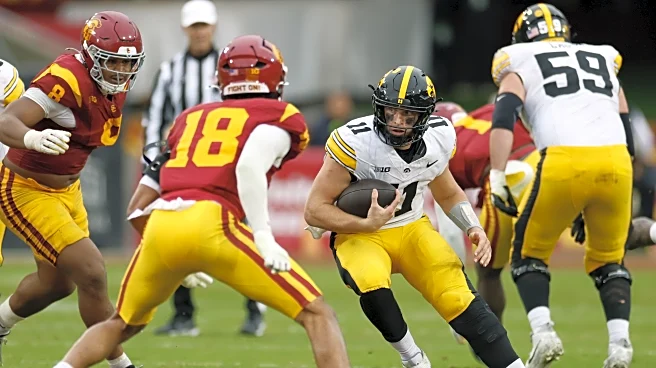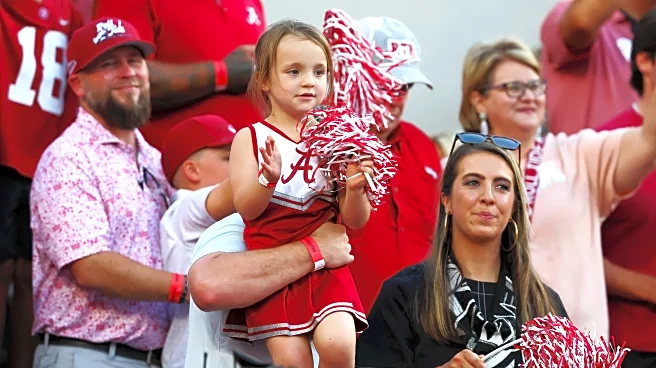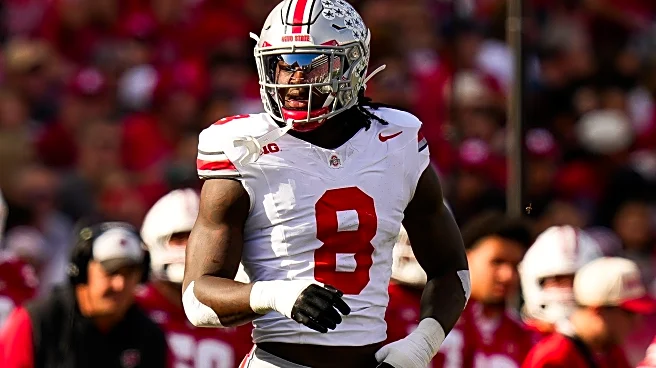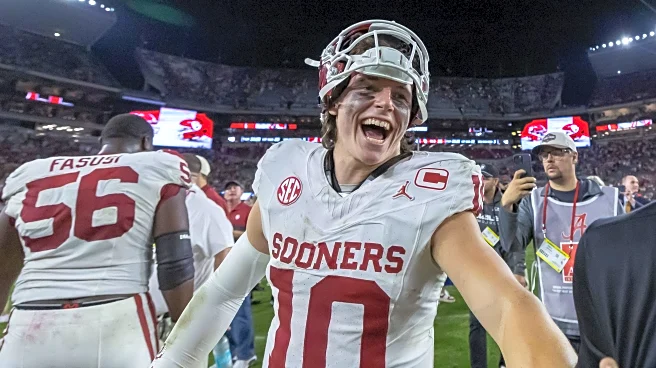Since their first bye week of the season Oregon’s offense had gotten off to slow starts against Indiana, Wisconsin, and Iowa (they scored at will against a Rutgers team that by some metrics is the worst
of all 18 defenses in the Big Ten). The trend was shattered against Minnesota at home: after both teams had possessed the ball twice Oregon held a 14-0 lead. A poorly executed trick play resulted in a fumble that led to a Golden Gophers field goal, but the 11-point margin was as close as the score got the rest of the night.
Oregon began rotating in more defensive reserves after taking a 35-13 lead late in the third quarter, but Minnesota’s offense didn’t meaningfully change their personnel or play calling at that point – it wasn’t until they chose to punt on 4th and long to end that possession, at the very end of the 3rd quarter, that Minnesota finally waved the white flag. Excluding each team’s final possession of the first half (with less than a minute left) this leaves 6 meaningful drives for both offenses. All five drives that didn’t end in a turnover were full-field (40+ yards) touchdowns for the Ducks. The Golden Gophers only had two full-field scoring drives, one for a field goal and one for a touchdown. Their other field goal came on a short field after the fumble.
Offense
Ongoing injuries to several offensive starters led to some unusual personnel usage in this game. Starting RT #71 Alex Harkey had been listed as questionable and didn’t play against Iowa so OT #78 Genorris Wilson started in his place last week. On Friday Harkey was still listed as questionable, but Wilson was noted as simply being out, so Harkey gutted it out and played the whole game. Whether simply in response to Harkey being at less than 100%, or possibly as an experiment, the staff flipped the roles for the guards with OG #74 Dave Iuli changing to the left side and OG #75 Emmanuel Pregnon (the highest graded lineman on my tally sheet) next to Harkey on the right.
The reshuffled line proceeded to turn in their best performance of the season with a 9% overall error rate. Some of that has to do with how play design was negating the highly aggressive Minnesota pass rush, but it still demonstrates that the line has continued to shake off the transfer portal effect as the season has gone on.
According to hythloday’s model, at this point the offensive line has probably shed as much of this effect as we can expect for the rest of the season. (Ed. note: There is actually a little extra potential room for improvement since this is a 14-week season and much of the data collection for the model comes from 13-week seasons; I expect late rather than mid-November to be the third inflection point of log-logistic decay in 2025.) I am very curious to see if the guards go back to their previous roles next week, though part of that may depend on the relative health of the right tackles.
Counting #7 Evan Stewart (who hasn’t seen any game action this season) Oregon entered this game with 3 of their top 4 wide receivers out. Though TE #18 Kenyon Sadiq was listed as questionable for this game (as he was last week when he didn’t play), the staff must have suspected he would be good to go as the game plan heavily emphasized the pass. While the rushing numbers were good, the passing numbers were simply spectacular. OC Will Stein must have seen many of the same vulnerabilities hythloday did on film and ruthlessly exploited Minnesota’s vulnerability to big plays.
While emphasizing the passing game Oregon only ran 18 called rush plays outside of garbage time. The efficiency and yards per carry were good, buoyed by a pair of super-explosive (30+ yard) touchdown runs. Indeed, I noted a number of play designs that looked to generate big plays by taking advantage of over-aggressive Golden Gopher defenders. Below is a representative sample of successful rushing plays.
(Reminder – You can use the controls in the bottom right of the embedded player to alter the playback speed and/or enter full screen mode.)
- :00 – This is a standard counter with two pullers, something Oregon has been doing since game 1 this season, but with an added twist. Watch QB #5 Dante Moore read the linebacker on the back side of the play. The offense had run this same play on the previous snap and Moore had kept it for over ten yards so the defense has to respect this threat. The blocking from the entire line and TE #9 Ja. Johnson is nearly perfect and occupies the remaining six defenders in the box. The only one left to stop RB #0 Davison is the single deep safety, and he gets juked out of his shoes.
- :37 – Minnesota is in man coverage, so the pre-snap motion from RB #23 Hill and post-snap movement from TE #18 Sadiq pulls three defenders toward the boundary. The threat of a QB keep freezes the defensive end and leaves a big cutback lane for Davison as the line seals off the box defenders.
- :44 – Including the nickelback to the offense’s left there are seven defenders in the box. Moore’s read occupies the linebacker on the back side. The blocking on this outside zone is not as well executed as the previous clips as both Sadiq and RG #75 Pregnon lose control of their assigned defenders. Davison is still able to cut downfield and lean forward for 6 yards on 1st & 10.
- :52 – This two-back set with Hill and RB #6 Whittington was a new wrinkle. Rather than serving as a lead blocker (as Davison often is in two-back sets), Whittington crosses Hill’s path to seal the backside and serve as eye candy for the linebackers. The double teams move the line of scrimmage, but C #72 Laloulu misses when moving up to the linebacker. Hill serves as his own blocker by powering forward for the first down.
As usual, the blocking error rates were higher in the run game than in the passing game. As expected, Minnesota frequently stacked the box and played with a single high safety. This resulted in a significant minority of rushes netting little to no gain. Some examples follow.
- :00 – Minnesota brings the boundary safety on a blitz and rotates the SAM (on the field because there are two tight ends, Ja. Johnson in line and Sadiq split out to the offense’s left) into coverage. This causes problems with the blocking assignments because the extra defender is now to the playside rather than to the backside where Moore can neutralize them with a read. The RT #76 Harkey should stick with the defensive end rather than stepping out to take the blitzer since the inside defender has the quickest route to Whittington.
- :08 – The Golden Gophers have dropped Minnesota DE #11 Menz into coverage expecting a pass with less than two minutes left in the half. The Ducks try to surprise them with a run where Ja. Johnson leads Whittington through the B-gap to the offense’s right. Minnesota linebacker #6 Baranowski plays it perfectly. He steps down on the run with his shoulders parallel to the line of scrimmage and fires into the gap. Ja. Johnson should pick him up but never sees him.
- :14 – Watch the nose tackle shoot into the gap left by Laloulu as he pulls to the offense’s left. LG #74 Iuli is responsible for the defender but can barely get hands on him. Combined with Laloulu being knocked down by the linebacker Davison never has a chance.
- :20 – The Golden Gophers’ other starting defensive tackle is now lined up at nose, but on the snap he slants into the B-gap on the offense’s right and splits the double team of Pregnon and Harkey. Whittington has to bounce outside where the SAM has discarded TE #83 Saleapaga and the safety is unblocked.
Quarterback Dante Moore noted in interviews after the game that he has changed to wearing a clear visor over his facemask as extra protection after his nose was broken against Wisconsin and that he was still adjusting to the change in his depth perception. This explains why several of his passes were uncharacteristically high in this game, but his receivers made some spectacular catches to bail him out. Despite the accuracy issues, Moore had his best game of the season in terms of decision making and reading the coverage. Here is a sample of successful passing plays.
- :00 – Minnesota appears to be running Cover-3 Cloud here, with both safeties and boundary corner bailing deep. Watch the field safety keep his eyes on Ja. Johnson running down the seam. He needs to rotate over to the sideline to pick up WR #4 Benson running down the sideline. I cannot tell if this is another errant throw by Moore, or if he was expecting tighter coverage and targeting the receiver’s back shoulder. Benson’s nifty footwork picks up a huge gain, but if he catches this in stride it is a touchdown.
- :24 – The telestrator handily highlights Sadiq, who is exactly who Moore wants to throw to. Again, the Golden Gophers are in Cover-3 so there are four defenders guarding the width of the field in the short yardage area. The nickelback, Minnesota #12, is in conflict because he has to stay close enough to WR #14 Lowe (off screen at the snap) if Moore throws to the far sideline. This creates a gap in the zone and the quarterback makes a quick throw before the defense can adjust.
- :37 – Oregon is facing 2nd & long so the Golden Gophers have their nickel personnel on the field even though both Sadiq (split out right) and Ja. Johnson (H-back to the left) are on the field. The boundary safety has to try to catch up to WR #11 McClellan running deep, so Ja. Johnson can split the two underneath defenders. The throw has to be high to get over the linebacker in the throwing lane, but it’s not too tall for the big tight end.
- :48 – In Thursday’s preview hythloday noted that rollouts could be effective at neutralizing Minnesota’s aggressive defense. OC Will Stein came to the same conclusion and had Moore on the move much of the night. Play action sucks up the linebackers so Sadiq is all alone running toward the sideline. The defensive end is also slowed down by the run fake so Moore has time to square his shoulders and deliver an accurate pass on the move.
With Moore going 27/30 on the night there were few failed passing plays to illustrate. The most common failures were screen plays. Oregon ran five screens and only two gained worthwhile yardage given the down & distance (including a successful shovel pass). Below are examples of the few failures in the passing game.
- :00 – With OT #76 Wilson out this game, R-Fr. #56 Trent Ferguson served as the 6th OL in heavy sets. Here he is on the offense’s left, along with three tight ends and Davison. The unbalanced formation confuses the coverage as two defenders follow Davison and TE #83 Saleapaga has nobody near him in the back of the endzone. Moore has to know he’ll have a free rusher coming at him on this play. He throws with open hips off his back foot and air mails the ball.
- :06 – The offense is trying to take Minnesota by surprise by throwing a pass out of their jumbo set with Ferguson on the offense’s right. This is another play action boot leg but the DE (Minnesota #0 A. Smith this time) doesn’t bite and throws Moore for a big loss. The Ducks fumbled on the ensuing third and long, setting up Minnesota’s first field goal.
- :21 – The Ducks ran three perimeter screens and only one of them worked. If the Golden Gophers had been playing man coverage this had a better chance to succeed, but in zone the corner has outside leverage against the block from McClellan. This delays Whittington getting around the corner so the safety can shove him out of bounds after only a two-yard gain.
- :29 – This is a great example of some of Moore’s accuracy issues on the night. An unbalanced formation to the offense’s left leaves Ja. Johnson 1-1 against the SAM linebacker and he’s open for a big play. The quarterback simply overthrows him.
Defense
Minnesota’s offense got a pleasant surprise when their best running back, #1 Taylor, was well enough to play having missed several weeks with an injury. Despite this, the Golden Gophers continued to primarily be a passing team. Indeed, their play calling was even more pass heavy than Oregon’s, with so few rushes that a separate statistical analysis of the run defense isn’t viable. This approach would make more sense if they were trying to throw intermediate and deep routes to come back from the early deficit. The confusing thing is that they only took a couple of deep shots early and then stuck to quick throws and screens after they fell behind.
I’m left puzzled as to exactly what Minnesota’s gameplan was trying to achieve. Their first drive consisted of trick plays that quickly led to a three-and-out. They then took a couple of deep shots and even hit one, but never went back to them. Quick passes are exactly what the Ducks’ mint front defensive structure is designed to counter but they leaned into this heavily. Oregon has proven vulnerable to efficiency rushing, and a healthy run/pass balance opens up opportunities for short and intermediate throws. Despite this most of Taylor’s carries came on direct snaps in short yardage and the run game seemed to be used only to try and catch the defense by surprise when in other down and distance situations.
Further discussion of the future of Minnesota’s offensive schemes can be left to the offseason previews. As far as this game is concerned, Minnesota simply never found any matchup they could consistently exploit against Oregon’s defense and the numbers speak for themselves.
With nearly 3/4s of all called offensive plays being dropback passes or screens, Oregon’s defenders could comfortably concentrate on playing pass defense knowing runs would rarely be an issue. The few times they had to defend the run, the Ducks front had opportunities to exploit the Golden Gophers’ poor offensive line play. Below are examples of successful rush defense.
- :00 – The Golden Gophers got their best RB back for this game and frequently got the ball to him on direct snaps. On this play the snap is high, which throws off the timing of the blocking. Immediate penetration by DE #29 Porter prevents the pulling H-back from getting to #9 Purchase who makes a textbook open field tackle before help arrives.
- :19 – Both blocking tight ends are in for this play and the defense is expecting a run. Playing 3-tech to the offense’s left, DT #1 Alexander tosses the OT aside and wraps up the ball carrier for a loss.
- :32 – When the left tackle steps outside to take on LB #28 Boettcher, it opens a path for DE #10 Uiagalelei who darts inside at the snap. The guard needed to leave Alexander to the center with two defenders to his left. By the time he looks over his left shoulder Uiagalelei is already by him on his way to the runner.
- :44 – In short yardage Minnesota #1 Taylor is behind center again. The read seems like a fake, I think Taylor was always going to keep this ball. Reserve DT #77 Je. Johnson gets interior penetration and forces Taylor to bounce outside. Backup LB #20 D. Williams takes on the lead back so fellow reserve S #12 Woodyard teams up with staring nickel #22 Canady to force 4th down.
Minnesota reserved much of their run game — about 40% — for shorter yardage situations that are difficult to defend, skewing the numbers a bit; still, their efficiency in these limited situations was impressive. Here is a sample of failed rushing defense.
- :00 – It’s 3rd & 1 with Taylor behind center, so there is no mystery what is about to happen. Mixon needs to scrape over the top of Uiagalelei to occupy the B-gap on the offense’s left. The line has clogged all the gaps on the right and #0 Austin can help if needed. On the left side Boettcher has to protect the edge so there is nobody else to fill in.
- :12 – The wide receiver split out to the offense’s right, Minnesota #3 Perich, is actually the starting boundary safety who is used in specialty plays like this one. He comes in motion to be the pitch man on a speed option to the field. From his “strong” safety position #31 Thieneman sees it and reacts correctly so the defense has the numbers to defend it. He takes a poor angle though, he needs to attack the blocker’s outside shoulder rather than trying to get around him. He ends up bumping into Canady and allowing extra yardage.
- :21 – The problems start up front when Porter cannot disengage from this blocker and the runner gets through the B-gap on the offense’s left. Thieneman does well to get around the receiver blocking him but he misses the tackle with a poor breakdown. The extra yardage turns a failed rush into a successful one.
- :37 – Oregon showed this all out blitz on 3rd & short when the Golden Gophers had an empty backfield and Minnesota had to burn a timeout as the play clock wound down while they adjusted. Once both teams returned to the field DC Tosh Lupoi needed to check out of this blitz because now the offense is ready for it. Despite there being only 4 yards to go none of the defenders are setting the edge against the run so Taylor just goes right by them. This was Minnesota’s longest run of the night on their only drive that ended in a touchdown.
The Ducks secondary stayed in man coverage most of the night and the Golden Gophers’ receivers struggled to gain significant separation. The pass rush also got significant pressure without having to blitz more often than usual. Minnesota did challenge the secondary with frequent screen passes, but more often than not Oregon had these handled. Below is a sample of successful pass defense.
- :00 – Minnesota decided to test CB #4 Finney early in the game, though I’m not sure why as he has by far the best coverage grades of any Oregon pass defender on my tally sheet. He shows advanced technique here: keeping proper leverage against the receiver, turning his head to play the ball, and getting his right hand around in front of the receiver. In the Pac-12 having any jersey in hand would usually be a penalty. In the Big Ten though so long as he doesn’t visibility impede the receiver there is no call.
- :17 – This bootleg to the offense’s right is designed to put Uiagalelei in conflict as he has to choose between pursuing the quarterback and covering the tight end. Both Boettcher and Mixon have other responsibilities in man coverage, but when they see where the ball is going they react immediately and Boettcher holds the play to a 1-yard gain.
- :36 – Pressure from his left forces Minnesota QB #5 Lindsey to abandon the pocket. He does well to buy time but his footwork is out of sync and his throw is wide of the mark. There was a window for a completion here, but it would have to be a very accurate pass as Finney was in good position.
- :57 – The Golden Gophers are in a tight formation with two backs and both receivers close to the line. This leaves the corners close enough to the QB for both to come on a blitz, something I haven’t seen before this season. Both RBs stay in pass protection, but Finney is coming in hot. Lindsey needs to throw this at the feet of one of the backs, but in haste he simply flings the ball downfield and the resulting intentional grounding call is as good as a sack.
There was no overarching pattern to the few failures in pass defense. The Golden Gophers made a few impressive plays, there were some missed tackles, and occasionally the offense simply called the better play. Some examples:
- :00 – Down two touchdowns and in 1st & short thanks to an offsides penalty Lindsey decides to test the 1-1 matchup to his right. There isn’t much more Finney could do here, it is just a very accurate pass and a strong catch.
- :23 – Uiagalelei drops into coverage while Boettcher fills in as a spy on the QB on second and long. The defense is in zone coverage and Uiagelelei is responsible for the short area to the boundary, so once Minnesota WR #0 Brockington crosses over the middle of the field he needs to pick up the running back leaking out. There is a quick reaction from CB #5 Th. Johnson and he has a chance to hold this to a short gain. He fails to wrap up and Minnesota RB #7 Ijeboi almost picks up the 1st down with yards after the catch.
- :50 – The Golden Gophers go back to their screen game on 3rd & 5. All three defenders over the teacup to the offense’s right react quickly. Another poor breakdown by Th. Johnson results in a conversion, however.
- 1:08 – Minnesota ran this running back outside screen twice and got 3rd down conversions with it both times. Boettcher is man coverage against the running back, so he needs to widen when Taylor does to avoid getting walled off by the center. With two deep safeties and the rest of the defense playing man coverage there is nobody in the middle of the field to stop Taylor.



